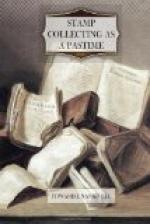Let me explain. In the stamp business, as in all other branches of commerce, there are wholesale and retail dealers. The wholesaler buys by the thousand stamps that are printed by the million. I refer, of course, to used stamps. In some cases the price paid per thousand is only a few pence for large quantities that run into millions. The wholesaler sells to the retail dealer at a small advance per thousand. Those stamps the ordinary dealer makes up into packets at a further profit, but still at a comparatively low price. Good copies he picks out for sale in sets and separately. Those have to be catalogued. Therefore, the catalogue price of common stamps bought and sold by the million eventually comes before the general collector at “one penny each,” and the man who makes a collection of common stamps of the “one penny each” class can scarcely be expected to realise a fortune out of his stamp collecting. When he offers his gatherings of years to the self-same dealer, and asks, say, only the half of what he paid, he is astounded when the dealer has the audacity to tell him frankly, “I can buy most of those stamps at a few shillings per thousand, and you want an average of a halfpenny each for them!” “But,” retorts the collector, “I paid you one penny each for them years ago, and now you won’t give me half that amount. A pretty thing investing money in stamps!” The reply of the dealer will be, “My dear fellow, you have put your money into the wrong stamps. I bought, and can still buy, those stamps wholesale at a few shillings per thousand, some of them at a few pence per thousand; but I have to pay clerks for handling them and sorting them out, other assistants for cataloguing them, and the printers for printing the catalogue, so that in the end I cannot afford to sell them separately for less than about one penny each, but if you want a few thousand of any value I can sell them to you at a price enormously below what you ask for your collection.” The collector’s eyes are opened.
It is impossible to get away from the necessity of regarding stamps as an investment. Even the schoolboy cannot afford to put his shilling into stamps unless he can be fairly assured that he may get his money back at critical periods, which will crop up even in school life. Indeed, it may be said that there are few, if any, stamp collectors nowadays who do not put more money into stamps than they could afford to do if there were not some element of investment in view. In some instances large fortunes are actually invested in stamps, and I was only recently told of a collector who had taken his money out of a very profitable business and put it into stamps, and had netted very much larger profits than he ever realised in his regular business. But to do that sort of thing requires a profound knowledge of stamps and a ready command of a very large banking account.
Generally speaking, the best countries from an investment point of view are British Colonials, especially those of the small colonies that have small populations, and therefore very small printings of stamps. Obviously, countries that put stamps into circulation by the million can never be a very good investment, so far as their common values are concerned. Those who buy with a keen eye on the investment purpose, always buy unused copies of uncommon values. Unused are not likely to depreciate, and they may appreciate.




